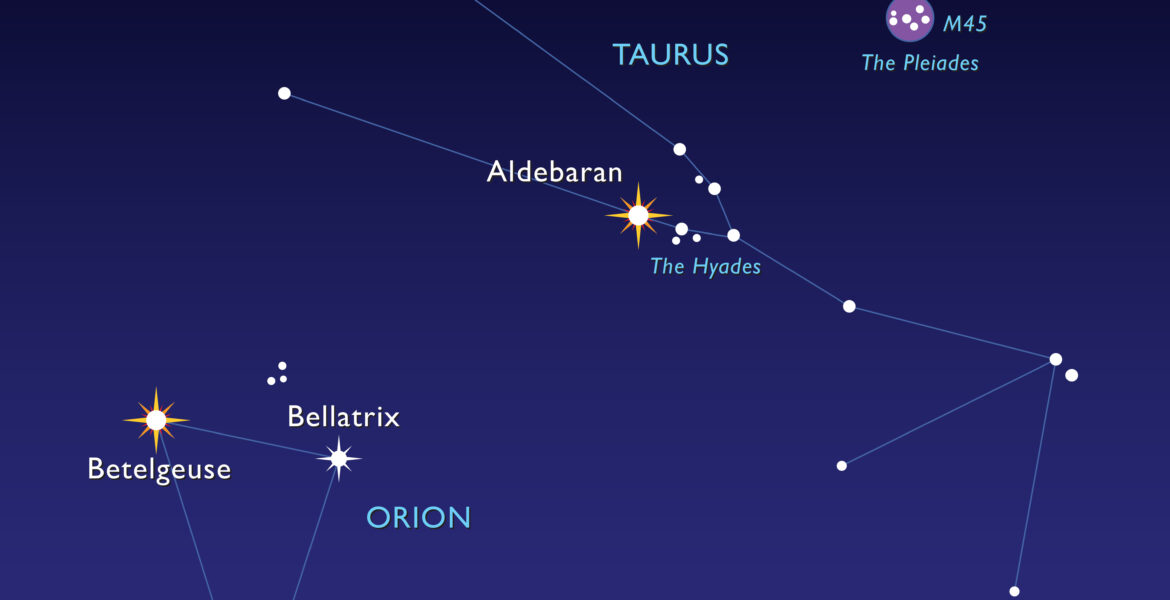“Canst thou bind the sweet influences of the Pleiades, or loose the bands of Orion?”
—Job 38:31
As the Sun, Moon, and planets make their way along the ecliptic through the winter sky they pass through the constellation of Taurus, a constellation of the zodiac. Because the Sun in winter is low in the day sky, the opposite side of the ecliptic is high in the winter night sky, so Taurus appears neatly overhead at sunset this time of year.
To find Taurus, locate our friend Orion as we did in the previous installment of the “Backyard Astronomer: The Winter Triangle.” The right side belt of Orion points roughly at a bright, orange-colored star called Aldebaran (see diagram). Aldebaran, or al-dabarān, is Arabic for “The Follower.” This star is the angry eye of Taurus the Bull.
Aldebaran also marks the top left side of a V-shaped asterism called the Hyades, one of two beautiful open clusters of stars in Taurus. The other is the glittering Pleiades, or the Seven Sisters. To find the Pleiades look to the right of Aldebaran and the Hyades to find six bright stars very close together in the shape of a small dipper.
Follow the V of the Hyades up to two stars that mark the horns of the bull. The brighter star is on the right and is called Elnath, or “The Butting” in Arabic. Elnath is shared by the neighboring constellation of Auriga. It is also called Beta Tauri (or the second brightest star in Taurus), or Gamma Aurigae (for the third brightest star in Auriga).
Last time we talked about the Great Orion Nebula as the birthplace of stars. The Pleiades was once very similar to the Orion Nebula. However, the stars in the Pleiades have now condensed out of the clouds of hydrogen that are still present in the Orion Nebula and are just further along in their evolution from gaseous nebula to open cluster. In fact, a long photographic exposure of the Pleiades will reveal the traces of nebulosity from the receding reflection nebula.
The Pleiades also has a Messier Catalogue number: M45, so, if you spotted the Orion Nebula (M42) from our last installment, you now have two Messier objects on your list!
Only six stars are clearly visible to the naked eye. There are varying accounts for the missing sister. The ancient Greeks named the sisters Maia, Electra, Alcyone, Taygete, Asterope, Celaeno and Merope. All the sisters took up with gods except Merope. She had the bad luck to hook up with that loser Sisyphus—the guy doomed to roll the rock up the hill every day only to find it back at the bottom of the hill the next morning. This explains why she never got a star on the cosmic walk of fame.
Most cultures have vivid stories about the Pleiades. Here in California, the Mono Indians of the eastern Sierra saw them as six sisters that were extremely fond of onions. So much so that their husbands kicked them out of the house. Regretting their rashness, the men went out searching for the malodorous maidens only to find that they had wandered off into the heavens.
As you might guess, the stars of the Pleiades are very young, hot stars. Pleione is a star that rotates so rapidly that she is approaching breakup velocity. This means that she is spinning so fast that she is highly elongated along her equator and probably throwing off a spiral of matter and close to exploding.
The Pleiades are also among the closest open clusters to Earth. Perhaps this explains why this bright knot of stars has attracted so much attention throughout history. They are mentioned in Homer’s “Iliad” and “Odyssey, The Bible, and by virtually every culture throughout history around the world.


she is close to exploding. Image courtesy Wikipedia


Thank you for your helpful diagram with this lesson! But my study has shown Saiph to be on the bottom left side of Orion, opposite Rigel, and with Bellatrix between Betelgeuse and Aldebaron rather than Saiph. Please let me know your explanation since I’m a new student and eager to learn.
Carolyn,
You are correct. That is Bellatrix! Thank you for pointing that out. Good catch. I tend to get a little over-focused when I make these charts. Thanks again, Eric
Very interesting, thank you! I didn’t know they were young stars. Many in the New Age community speak of them as if they are more ancient than our sun.
Lisa,
I guess it is a matter of perspective. While the Pleiades are young stars, they are unimaginably old in human terms. The depth of time is utterly inhuman.
Eric
Nice!!